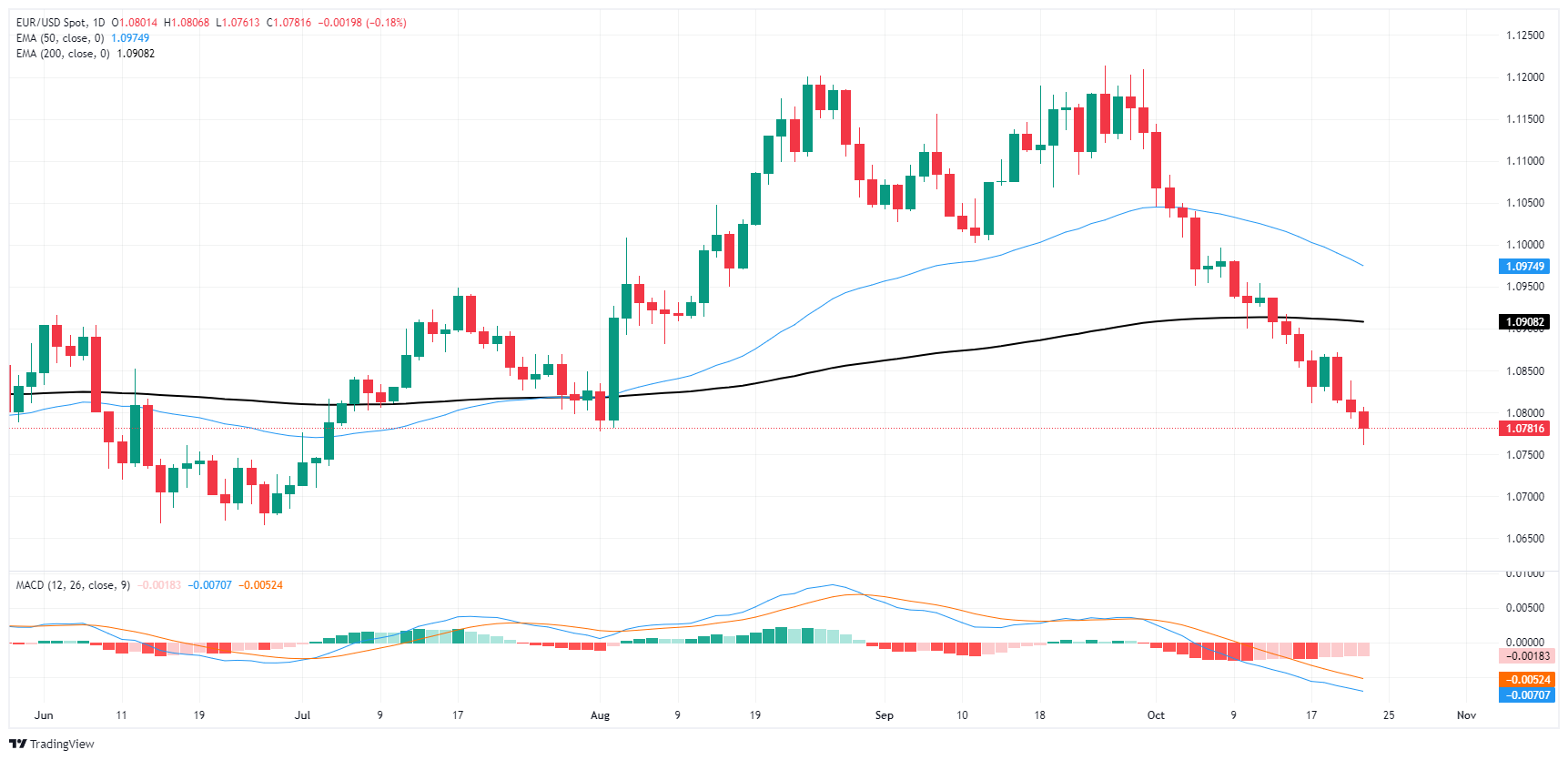EUR/USD sinks again, taps new 16-week bottom


- EUR/USD is down eight-tenths of a percent for the week.
- Fiber bids are getting crushed by waffling speech from ECB planners.
- EU and US PMI figures due on Thursday could spark fresh momentum.
EUR/USD shed another fifth of a percent on Wednesday as the Fiber crumples ahead of Thursday’s fresh round of Purchasing Managers Index (PMI) figures. ECB officials talked down economic concerns, reiterating the need for caution when weighing future rate cuts. FX markets promptly responded by pummeling the Euro further into the dirt, hitting a 16-week low.
Global PMI figures are due for a rolling release on Thursday. Markets have high expectations for pan-EU PMI survey results, with median market forecasts calling for a slight uptick in October’s EU Services PMI to 51.6 from September’s 51.4. On the US side, median market forecasts expect October’s US PMI figures to come in mixed, with the Manufacturing component expected to rise to 47.5 from 47.3, while the Services PMI component is expected to tick slightly lower to 55.0 from 55.2.
EUR/USD price forecast
EUR/USD continues to slide lower as the pair tests support near the 1.0780 level. The recent price action shows a significant breakdown below both the 50-day EMA, currently at 1.0975, and the 200-day EMA at 1.0908, signaling a shift in market sentiment to the downside. The sustained selling pressure has pushed the pair into a bearish phase, with sellers eyeing further downside towards the 1.0750 support zone. A break below this key psychological level could trigger a more aggressive selloff towards the 1.0700 handle.
The MACD indicator remains firmly in bearish territory, with the MACD line continuing to trend below the signal line and the histogram deepening in negative values. This suggests that downward momentum is still intact, and any attempts at a reversal may face stiff resistance. Traders should be cautious of oversold conditions, but as long as the price remains below the moving averages, the bearish bias will likely persist. Any bounce from current levels could face immediate resistance near the 1.0900 region, making it a key level to watch for potential shorting opportunities.
EUR/USD daily chart
Euro FAQs
What is the Euro?
The Euro is the currency for the 19 European Union countries that belong to the Eurozone. It is the second most heavily traded currency in the world behind the US Dollar. In 2022, it accounted for 31% of all foreign exchange transactions, with an average daily turnover of over $2.2 trillion a day. EUR/USD is the most heavily traded currency pair in the world, accounting for an estimated 30% off all transactions, followed by EUR/JPY (4%), EUR/GBP (3%) and EUR/AUD (2%).
What is the ECB and how does it impact the Euro?
The European Central Bank (ECB) in Frankfurt, Germany, is the reserve bank for the Eurozone. The ECB sets interest rates and manages monetary policy. The ECB’s primary mandate is to maintain price stability, which means either controlling inflation or stimulating growth. Its primary tool is the raising or lowering of interest rates. Relatively high interest rates – or the expectation of higher rates – will usually benefit the Euro and vice versa. The ECB Governing Council makes monetary policy decisions at meetings held eight times a year. Decisions are made by heads of the Eurozone national banks and six permanent members, including the President of the ECB, Christine Lagarde.
How does inflation data impact the value of the Euro?
Eurozone inflation data, measured by the Harmonized Index of Consumer Prices (HICP), is an important econometric for the Euro. If inflation rises more than expected, especially if above the ECB’s 2% target, it obliges the ECB to raise interest rates to bring it back under control. Relatively high interest rates compared to its counterparts will usually benefit the Euro, as it makes the region more attractive as a place for global investors to park their money.
How does economic data influence the value of the Euro?
Data releases gauge the health of the economy and can impact on the Euro. Indicators such as GDP, Manufacturing and Services PMIs, employment, and consumer sentiment surveys can all influence the direction of the single currency. A strong economy is good for the Euro. Not only does it attract more foreign investment but it may encourage the ECB to put up interest rates, which will directly strengthen the Euro. Otherwise, if economic data is weak, the Euro is likely to fall. Economic data for the four largest economies in the euro area (Germany, France, Italy and Spain) are especially significant, as they account for 75% of the Eurozone’s economy.
How does the Trade Balance impact the Euro?
Another significant data release for the Euro is the Trade Balance. This indicator measures the difference between what a country earns from its exports and what it spends on imports over a given period. If a country produces highly sought after exports then its currency will gain in value purely from the extra demand created from foreign buyers seeking to purchase these goods. Therefore, a positive net Trade Balance strengthens a currency and vice versa for a negative balance.





.jpg)